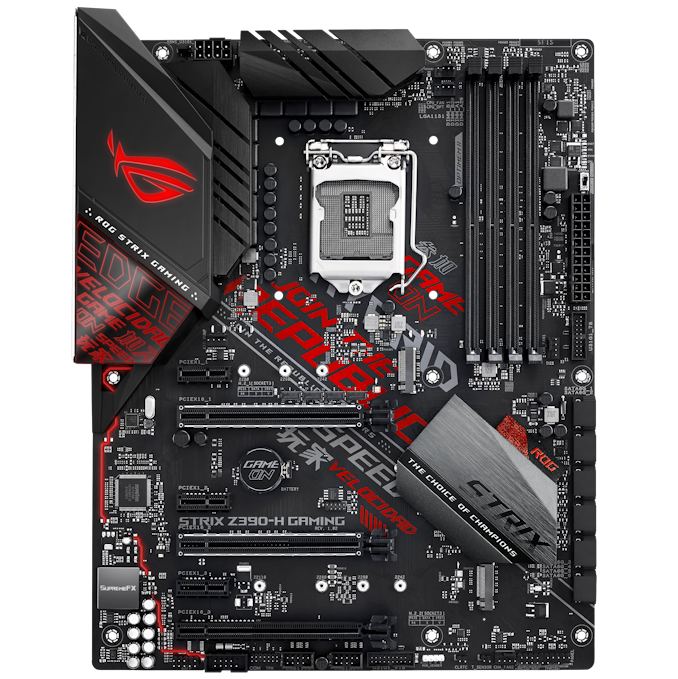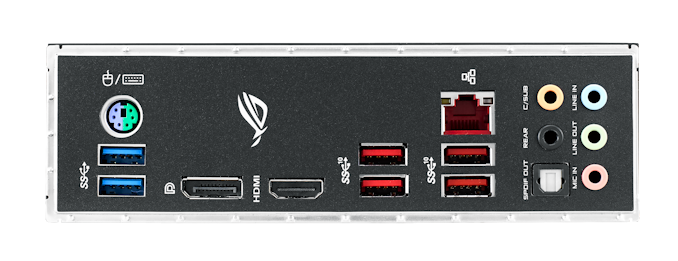Intel Z390 Motherboard Overview: 50+ Motherboards Analyzed
by Ian Cutress & Gavin Bonshor on October 8, 2018 10:53 AM EST- Posted in
- Motherboards
- Intel
- MSI
- Gigabyte
- ASRock
- EVGA
- Asus
- NZXT
- Supermicro
- Z390
ASUS ROG Strix Z390-H Gaming
Although the ROG Strix Z390-H retains the same PCB layout as the Strix Z390-E model, the visuals are much more aggressive with a red and black theme throughout; the Edge branding on the rear panel cover matches this particular color scheme. The Z390-H has three full-length PCIe 3.0 slots which operate at x16, x8 and x4 respectively, with the top two also featuring a coating of metal slot reinforcement protection. Like the Z390-E, the Z390-H has three available PCIe 3.0 x1 slots.
Storage capability is rather standard as far as Strix branded 300 series boards go with two M.2 slots available, with one having just PCIe 3.0 x4 support and the other allowing for SATA based drives to be used too. The six available SATA ports are placed differently on the Strix Z390-H with all six ports being aligned vertically in single and an individual array. RAM support is standard for an ATX sized board with four available slots with support for DDR4-4266 and a total combined capacity across all slots of up to 64 GB.
A slightly less comprehensive set of rear panel connectors marks a shift in the ASUS crammed rear panels, but still is remarkably impressive overall as the Strix Z390-H Gaming has a total of four USB 3.1 Gen2 Type-A and two USB 3.0 Type-A ports. In addition to this is a pair of video outputs with an HDMI and DisplayPort both being featured, with a PS/2 combo port, single Intel I219V Gigabit powered LAN port and a set of onboard audio connectors controlled by a ROG SupremeFX S1220A audio codec.
The ASUS ROG Strix Z390-H Gaming has an unknown pricing as of yet and is one of the only red and black themed boards on the whole of the Z390 chipset. The ROG logo on the rear panel is RGB and offers compatibility with the ROG AURA Sync RGB software, with the most notable point is the board's inclusion of four USB 3.1 Gen2 Type-A ports; sorry, no USB Type-C whatsoever on the Z390-H Gaming.












79 Comments
View All Comments
pawinda8 - Monday, October 15, 2018 - link
Still no mention of any Z390 boards with native Thunderbolt 3 (not AIC)! Has Intel given up on Thunderbolt for the PC world?gavbon - Monday, October 15, 2018 - link
If it's not integrated into the chipset, it's not really native as such. The ASRock Z390 Phantom Gaming-ITX/ac has a Thunderbolt 3 port on the rear panel, but that's the only one I'm afraidHikariWS - Monday, October 15, 2018 - link
Oculus Rift requires 3 USB3 ports and doesn't accept any of them being connected to a hub, they all need to be connected directly into a raw port. I had to buy a dedicated 3GIO USB 3 board that added 6 useful extra ports. In my (yes, old) Gigabyte z87 mobo I also had issues using keyboard and mouse on USB 3 ports inside UEFI and some recovery softwares, so I had to buy a USB 2 mirror to connect them.Because of that, having USB 2 ports on front panel and nice quantity of USB 3 is what most differs mobos for me, given that all other features are nearly the same.
ASUS Z390-A seems to be the best option. It has the important double USB2 ports, 5 USB3 ports and still has HDMI and DP for emergencies.
just4U - Monday, October 15, 2018 - link
I wish MSI had released a "godlike" board for the Ryzen series.ThugEsquire - Tuesday, October 16, 2018 - link
You list the ASRock Z390 Phantom Gaming-ITX/ac above as an ATX board, but it's actually mITX. FYIgavbon - Friday, October 19, 2018 - link
I have gone through every page where the Phantom Gaming-ITX/ac is listed, but I can't see where it says it's an ATX board? Could you please be more specific? Are you viewing on mobile or desktop?Galcobar - Tuesday, October 16, 2018 - link
It would be really helpful to break out one more criteria into a table: Type-C header for case-front ports.Helping a friend put together an i5 system and, knowing he'll keep it for a long time, am trying to get even with peripheral connectors (already has a monitor, so no using that as a hub). It's relatively easy to identify cases with a Type-C port, but that's pointless without a motherboard header. Having to go into each board's page to check is time-consuming.
jjnam - Thursday, April 18, 2019 - link
6 months later and I'm here for EXACTLY this reason. I've gone through probably 50 manuals over the past few days squinting to find this information. What a pain.Synomenon - Thursday, October 18, 2018 - link
So on the ASRock Z390 Phantom Gaming-ITX/ac, is the TB3 port on the rear using up lanes from CPU (making the only 16x slot, 8x only)?If it's not using lanes from the CPU, how will using that TB3 port (say with a USB3.1 Gen2 hub OR TB3 hub) affect all the other ports / IO on the board?
repoman27 - Thursday, October 18, 2018 - link
Going off of what TweakTown published, it's a single-port Intel JHL6240 "Alpine Ridge" controller with a PCI 3.0 x2 connection to the PCH. So it won't affect the PEG lanes from the CPU. I'm amazed it's not Titan Ridge at this point though.